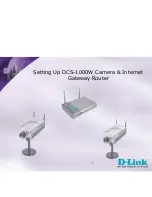
Troubleshooting
64
8.
If your are unable to communicate with the router through NMS.
The Network Management System (NMS) communicates with the router through Ethernet using
the SNMP protocol. If your NMS is unable to get SNMP response from the router, check the
following :
Ping a known active station in the local Ethernet. If you are unable to receive the ICMP
response, you may have problem with your TCP/IP installation. Check the NMS Ethernet cable,
NIC, and TCP/IP configuration.
If you are able to ping other TCP/IP stations but not the ISDN router. Make sure that the ISDN
router is active, and it is assigned with the correct IP address.
9.
If your are unable to make voice call
If you are unable to make a voice call when there is no B channel or only one B channel is in use
as indicated by the B channel LEDs. Check the RJ11 telephone cable and the analog device
itself.
10.
If your are unable to make a data call
This is a more complicated problem than any of the previous list. It is suggested that you use
NMS statistics, and trace utilities to help you perform the diagnosis. The NMS trace utility show
you the network activities in detailed. The NMS statistics give you detailed LAN and WAN
frame count.
If you are sending traffic towards an Internet or Intranet, but the B channel LED or trace window
shows no ISDN activities. You should check your IP network configuration.
If the ISDN router fails at the ISDN dialing attempt, check the telephone number configured.
The number has to be one associated with an ISDN data device at the remote end. The trace
windows should provide you with the precise error message.
If the ISDN call is connected briefly for a few seconds, and then disconnected. Mostly likely
your PPP configuration mismatches the remote end. Check your PPP configuration including PPP
authentication protocol, and password.
Index
1
1->0 Idle .............................................. 4-20, 4-29
1->2 Utilization ................................... 4-20, 4-28
2
2->1 Utilization ................................... 4-20, 4-28
A
access list...................................................... 4-15
Analog Services features ................................ 1-3
ARP Proxy.................................................... 4-15
average interval ................................... 4-20, 4-28
B
bandwidth-on-demand.................................. 3-11
B-channel alarm threshold............................ 4-12
bridging .......................................................... 3-4
browser management .................................... 4-42
C
call ID ........................................................... 4-25
call-back........................................................ 4-25
Callback ........................................................ 3-13
Caller ID ..............................................3-13, 3-20
call-in authentication.................. 4-10, 4-20, 4-28
call-in password ......................... 4-10, 4-20, 4-28
calling number .............................................. 4-25
Challenge Authentication Protocol ................. 3-9
CHAP.............................................................. 3-9
community
read ....................................................4-35
read-write ...........................................4-35
compression ................................. 4-9, 4-19, 4-26
Concepts & Principles of Operations.............. 3-1
configuration and management ....................... 4-1
Connection Profile .......................................... 3-4
Console management .................................... 4-40




































